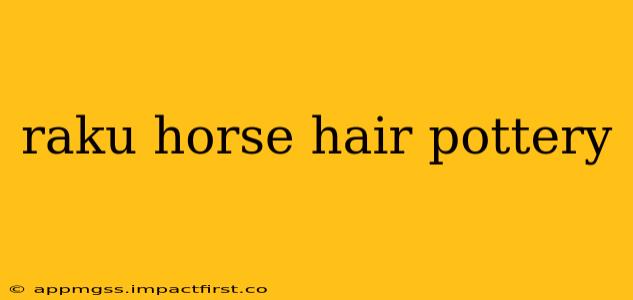Raku pottery, known for its dramatic, unpredictable glazes and earthy textures, finds a particularly captivating expression when combined with the unique artistry of horsehair. This technique, adding a layer of rustic elegance, results in stunning pieces that are both functional and highly collectible. This article delves into the fascinating world of raku horsehair pottery, exploring its history, techniques, and the artistry behind its creation.
What is Raku Horse Hair Pottery?
Raku horsehair pottery is a specific type of raku ware where strands of horsehair are applied to the still-hot pottery piece during the reduction firing process. The intense heat causes the hair to burn, leaving behind striking black or brown marks that contrast beautifully with the underlying glaze. The resulting patterns are unique and unpredictable, reflecting the inherent spontaneity of the raku firing process. Each piece is truly one-of-a-kind, a testament to the artist's skill and the unpredictable nature of the fire.
How is Horsehair Applied to Raku Pottery?
The application of horsehair is a crucial and precise step in creating raku horsehair pottery. The process typically involves the following:
- Preparation: The piece is meticulously glazed and then fired in a raku kiln to a specific temperature.
- Application: Once the piece is removed from the kiln (while still incredibly hot), the artist swiftly and carefully applies the horsehair using tongs. The heat instantly burns the hair, leaving its mark.
- Reduction Firing: The piece is often placed into a reduction chamber (a container where the oxygen supply is reduced) to further enhance the color and depth of the design. This step can further intensify the contrast between the horsehair marks and the underlying glaze.
- Cooling: After the firing is complete, the piece is carefully allowed to cool.
The precise timing, technique, and type of horsehair used all contribute to the final aesthetic, resulting in pieces with a wide range of visual effects.
What are the Different Styles and Variations of Raku Horse Hair Pottery?
While the fundamental technique remains consistent, artists express their creativity through several variations:
- Different Hair Colors and Types: The use of different colored or textured horsehair can lead to variations in the final marks.
- Glaze Combinations: The base glaze significantly influences the final appearance of the horsehair marks. Different glazes interact with the burned hair in unique ways.
- Layering Techniques: Applying multiple layers of horsehair, or layering the horsehair with other materials, can create complex and intricate designs.
- Combined Techniques: Artists sometimes combine horsehair application with other raku techniques, such as using metallic oxides or applying additional glazes after the horsehair firing.
Is Raku Horse Hair Pottery Difficult to Make?
Creating high-quality raku horsehair pottery requires a significant level of skill and precision. The intense heat and short firing times demand experience and a good understanding of the raku process. The timing of horsehair application is critical, requiring a steady hand and swift execution. The unpredictable nature of the process means that even experienced artists face the possibility of unexpected results. It's a technique that often rewards patience, practice, and a willingness to embrace the unexpected.
How Much Does Raku Horse Hair Pottery Cost?
The price of raku horsehair pottery varies widely depending on several factors:
- Artist's Reputation: Well-established artists often command higher prices.
- Size and Complexity: Larger and more intricate pieces tend to be more expensive.
- Materials Used: The type of glaze and horsehair can influence the cost.
- Uniqueness: The one-of-a-kind nature of each piece contributes to its value.
Generally, you can expect to find raku horsehair pottery ranging from moderately priced functional pieces to significantly more expensive, highly collectible works of art.
Where Can I Buy Raku Horse Hair Pottery?
Raku horsehair pottery can often be found at art fairs, craft shows, and online marketplaces. Many artists sell their work directly through their websites or studios. Searching online for "raku horsehair pottery" or "raku pottery artists" will uncover numerous options, allowing you to explore the diverse styles and price points available.
What Makes Raku Horse Hair Pottery Unique?
The uniqueness of raku horsehair pottery stems from the unpredictable nature of the firing process and the interplay between the horsehair, glaze, and intense heat. Each piece is truly one-of-a-kind, carrying the marks of the fire and the artist's skill. This combination of spontaneity and artistry makes it a highly valued and sought-after form of ceramic art. The rustic charm and the bold marks create pieces that are both visually stunning and full of character.
This exploration into the world of raku horsehair pottery showcases its intricate process, artistry, and the unique characteristics that make each piece a captivating work of art. The unpredictable nature of the firing process and the skillful application of horsehair contribute to the creation of pieces that are both functional and deeply expressive.
